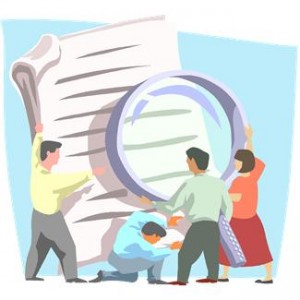Speaking of the survey (Part 1): A look at who responded and how
08 October 2012 – editors
 Editor’s note: This summer, the National Council on Public History asked public historians, including its own members but also other readers of its publications, to comment on the current state and possible future directions of The Public Historian journal and other NCPH media. For some background on the reasons for the survey, read Bob Weyeneth’s recent post on the journal. In order to open up the ongoing conversation and deliberations as widely as possible, History@Work will be publishing a series of reports drawn from the survey data. First up, an overview of the survey, the respondents, and some next steps in the process. We welcome any additional layers of response and analysis that blog readers may want to contribute!
Editor’s note: This summer, the National Council on Public History asked public historians, including its own members but also other readers of its publications, to comment on the current state and possible future directions of The Public Historian journal and other NCPH media. For some background on the reasons for the survey, read Bob Weyeneth’s recent post on the journal. In order to open up the ongoing conversation and deliberations as widely as possible, History@Work will be publishing a series of reports drawn from the survey data. First up, an overview of the survey, the respondents, and some next steps in the process. We welcome any additional layers of response and analysis that blog readers may want to contribute!
__________________________________________________
from John Dichtl, Executive Director, National Council on Public History:
When you ask people to be critical, especially historians, they’ll often oblige. And if you ask in the form of an anonymous online questionnaire, their feedback is likely to be—shall we say—especially honest.
The 627 respondents to NCPH’s 56-question Public History Readers Survey were precise about what they like and don’t like in The Public Historian, the NCPH newsletter, this blog, and other publications. While many comments head in different, sometimes contradictory directions, the overall tone was one of eagerness to discuss change. A typical remark was this one regarding the core significance of the journal: “I think NCPH has an amazing opportunity here. It will not be without bumps along the road—we need to convince some people to come back to the table, for one—but this can make a stronger publication and a stronger organization.”
It’s going to be a challenge to digest all the responses. At more than 50 questions, the survey elicited a mix of quantitative information and longer, more qualitative and open-ended answers. One of the key questions, which I think many of us involved in designing the survey hoped would make the path forward clearer, was the one that asked for “exciting models” of publications in any field or discipline. Two hundred and twenty nine people responded to this question, yet they named more than 100 different publications. Talk about a “long tail” response. Public history obviously is a big tent that brings together individuals with many different backgrounds and interests and reading lists.
Respondents seem to represent the diversity of the field in other ways, too. Over half are members of NCPH, but half are not. Half are 18-44 years old and half 45 or older. About 30% are at colleges or universities, 15% at museums, 10% in the federal government, 9% are consultants, 8% in historical organizations or archives, 7% in state and local government.
We have a rich body of information to analyze. Working on this is The Public Historian Editorial Board, which will meet to discuss the survey in a couple of weeks. So will the NCPH Board of Directors, on October 19-20. Meanwhile, NCPH has a Journal Task Force poring through the survey results. And several members of the group will be offering their initial thoughts on History@Work in posts following this one.
The task force consists of Michelle Delaney (Smithsonian), John Dichtl (NCPH), Rebekah Dobrasko (South Carolina State Historic Preservation Office), Andreas Etges (Freie Universität Berlin), Laura Feller (Independent Historian), Jim Gardner (National Archives), Heather Miller (Historical Research Associates Inc.), Patrick Moore (University of West Florida), Linda Shopes (Independent Historian), Cathy Stanton (NCPH Digital Editor; Tufts University), Robert Townsend (American Historical Association), Bob Weyeneth (University of South Carolina), Anne Whisnant (UNC Chapel Hill), and Bill Willingham (Independent Historian).
Below are some further details on the demography of survey respondents:
Country – 517 answered
28 (5% of those answering) are not U.S.
Canada – 11; UK – 7; Germany, New Zealand, Italy, Belgium, Singapore, France, India, Columbia, Spain, and Hong Kong 1 each.
Age – 524 answered
- 18-30 years 122 (23.3% of those answering)
- 31-44 years 153 (29.2%)
- 45-65 years 212 (40.5%)
- 66+ years 37 (7.1%)
Highest Earned Degree – 513 answered
67 MA students (13% of those answering); 52 PhD students (10%); 262 are MA students or whose highest degree is an MA (51%) vs. 225 (44%) PhD students or who have a PhD
Principal Employment – 526 answered
- College/University – 30%
- Museum – 15%
- Federal Govt. – 9.5%
- Consultants (self-employed + cons. firm) – 9%
- Historical Org. or Archives/Library/Center – 8.1
- State/Local Govt. (state + local) – 7%
Years Employed as Public Historian
- 0-2 years 23%
- 3-5 years 17%
- 6-10 years 15%
- 10-20 years 23%
- 20+ years 22%
NCPH Membership
- Never 22%
- Lapsed 84 (16%)
- Yes 285 (54%)



